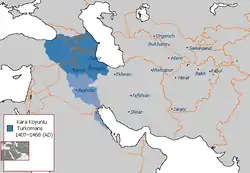Yıva
Yıva (Azerbaijani: Yıva, Turkish: Yıva, Turkmen: Ywa) is one of the 24 ancient Oghuz (Turkoman) tribes.[1][2] The Yıva tribe belonged to the tribe of Dengiz Khan, the youngest son of Oghuz Khagan.
 Tamgha of the Yıva tribe | |
| Regions with significant populations | |
|---|---|
| Azerbaijan, Turkey, Turkmenistan | |
| Languages | |
| Oghuz Turkic | |
| Religion | |
| Islam | |
| Related ethnic groups | |
| Oghuz Turks |
Part of the Yıva, led by Suleyman Shah, moved from Central Asia to Western Iran and the upper reaches of Tigris and Euphrates in the 13th century. The capital of Suleyman Shah became the city of Bahar (near Hamadan). Suleyman Shah led the defense of Baghdad against the Mongols of Hulagu and was defeated.[3]
Yıva are notorious for establishing the Kara Koyunlu Turkoman state.[4]
History
By the 14th century, the Yıva had established a foothold in eastern Anatolia, and took possession of the area comprising the Van Lake and the surroundings of Mosul.[5]
Kara Koyunlu

The Kara Koyunlu or Qara Qoyunlu, also called the Black Sheep Turkomans were a Muslim Turkoman[6][7][8] monarchy that ruled over the territory comprising present-day Azerbaijan, Georgia, Armenia, northwestern Iran, eastern Turkey, and northeastern Iraq from about 1374 to 1468.[9][10]
In the 14th century, the rulers of the Yıva tribe were able to bring together several other Turkic tribes and clans, such as Baharlu, Saadlu, Karamanlu, Alpaut, Duharlu, Jagirlu, Khajilu, Agacheri, forming a tribal confederation called Kara Koyunlu, named after the image of a black sheep on their banners.
Yıva today
Descendants of the Yıva tribe are assimilated into Azerbaijani, Turkish and Turkmen turks. Sizable group of the Yıva, mostly ethnic Turkmens, also live in the Olat region of Bukhara, Uzbekistan.[11]
References
- Fazlallah Rashid ad-Din (1858). "Legends about Oghuz Khagan. Tribal division of the Turkmens. (Extracts from Jami at-Tavarikh)". Medieval Historical Sources of the East and West. Eastern Branch of the Russian Archaeological Society, vol. V and XV, St. Petersburg.
- Abulghazi (1958). "The Genealogy of the Turkmen". Medieval Historical Sources of the East and West. Academy of Sciences of the USSR.
- Ryzhov, K.V. Kara-Koyunlu. All the monarchs of the world. The Muslim East. VII-XV centuries. Veche, 2004
- Peter B. Golden, «An Introduction to the History of the Turkic Peoples», p. 367-368
- Clifford Edmund Bosworth. The new Islamic dynasties: a chronological and genealogical manual. — Edinburgh University Press, 2004 — p. 273—274 — ISBN 0-7486-2137-7
- Philippe, Beaujard (2019). The Worlds of the Indian Ocean. Chapter 17 - Western Asia: Revival of the Persian Gulf: Cambridge University Press. pp. 515–521. ISBN 9781108341219.CS1 maint: location (link) "In a state of demographic stagnation or downturn, the region was an easy prey for nomadic Turkmen. The Turkmen, however, never managed to build strong states, owing to a lack of sedentary populations (Martinez-Gros 2009: 643). When Tamerlane died in 1405, the Jalāyerid sultan Ahmad, who had fled Iraq, came back to Baghdad. Five years later, he died in Tabriz (1410) in a battle led against the Turkmen Kara Koyunlu (“[Those of the] Black Sheep”), who took Baghdad in 1412."
- "Kara Koyunlu". Encyclopaedia Britannica. "Kara Koyunlu, also spelled Qara Qoyunlu, Turkish Karakoyunlular, English Black Sheep, Turkmen tribal federation that ruled Azerbaijan, Armenia, and Iraq from about 1375 to 1468."
- The Book of Dede Korkut (F.Sumer, A.Uysal, W.Walker ed.). University of Texas Press. 1972. p. Introduction. ISBN 0-292-70787-8. "Better known as Turkomans... the interim Ak-Koyunlu and Karakoyunlu dynasties..."
- Hovannisian, Richard (2004). The Armenian People from Ancient to Modern Times. Palgrave Macmillan. p. 4. ISBN 1403966362.
- Encyclopædia Britannica. "Kara Koyunlu". Online Edition, 2007
- Ataniyazov, S. Dictionary of the Turkmen ethnonyms. Ylym; Ashgabat. 1988.
